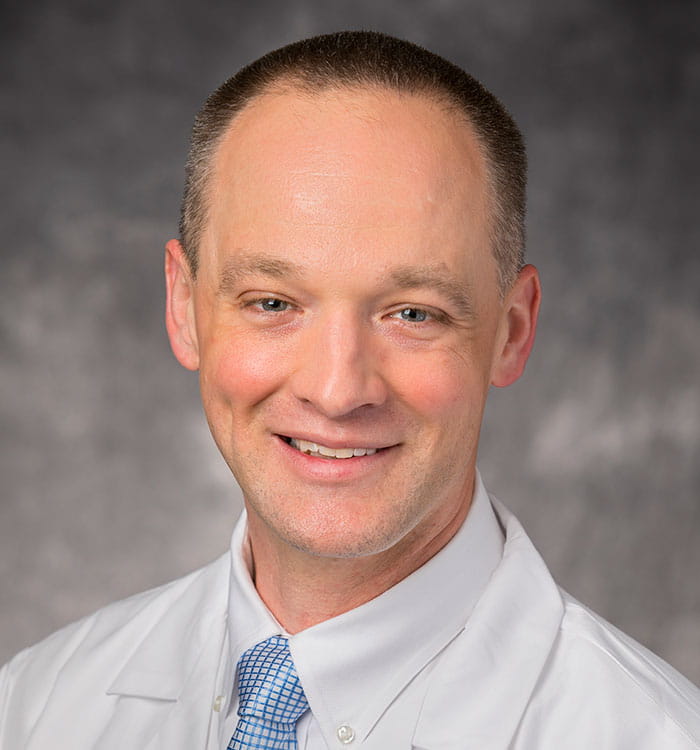Enhanced Bronchoscopy Suite at UH Cleveland Medical Center Offers Increased Access for Patients, New Diagnostic and Therapeutic Options
April 21, 2019
Program among the first in the U.S. to use a new genomic test for diagnosing idiopathic pulmonary fibrosis
UH Clinical Update - April 2019
New capital investment in the bronchoscopy suite at UH Cleveland Medical Center and increased support from anesthesia are helping the interventional pulmonology team here serve a growing number of UH patients.
“In 2018, we expanded our capabilities in the bronch suite to offer the full gamut of diagnostic and therapeutic bronchoscopic procedures,” says Benjamin Young, MD, Medical Director of Bronchoscopy at UH Cleveland Medical Center and Assistant Professor of Medicine at Case Western Reserve University School of Medicine. “With these advances, we’ve seen a steady increase in our procedural volume. From 2017 to 2018, there was a 25 percent increase in the number of procedures performed. And already in 2019, we’re on pace to do about 15 percent more procedures than we did in 2018.”
 Benjamin Young, MD
Benjamin Young, MDWith new support from anesthesia, Dr. Young says he expects further growth.
“Earlier this month we had a huge increase in our support from anesthesia, which will allow us to do more advanced procedures and cut down the delays in scheduling that we’ve experienced before,” he says. “Increasing access is the big thing, decreasing patient wait times for those types of procedures.”
One key new capability is the ability to perform rigid bronchoscopy in the bronchoscopy suite, as opposed to in the operating room.
“The rigid bronchoscopy procedures are mostly just for therapeutic purposes – probably less than 5 percent of what we do overall,” Dr. Young says. “But it’s another tool we have when it’s needed. It allows more control of the airway in a patient who has a central airway tumor. Also, the only way to place silicone stents is through rigid bronchoscopy.”
The enhanced bronchoscopy suite has also been site to several UH firsts, Dr. Young says. In 2018, the UH interventional pulmonology team treated its first three asthma patients using bronchial thermoplasty.
“This intervention decreases the amount of smooth muscle in the central airways,” he says. “It’s that smooth muscle that leads to the bronchoconstriction and wheezing. In the right patient, it can make a big difference in their quality of life. It’s not going to be for everybody, but there are people we can help. We’re still looking for potential candidates, working with the other pulmonologists, primary care, allergy/immunology colleagues to help identify appropriate patients. The best candidates are people with severe, persistent asthma that’s not well-controlled.”
The interventional pulmonology team has also performed its first transbronchial cryobiopsy for diagnosing interstitial lung disease. In addition, it was the first program east of the Mississippi to use the Envisia genomic classifier test on biopsied lung tissue to diagnose idiopathic pulmonary fibrosis (IPF), the most common, deadly and difficult-to-diagnose interstitial lung disease.
“Our typical bronchoscopic lung biopsy has very limited utility in evaluating people with interstitial lung disease,” Dr. Young says. “You need larger pieces of tissue for the pathologist to be able to see the architectural changes in the lung needed to make a diagnosis. Historically, these patients have had to undergo surgical lung biopsy which has involved an incision in the chest, chest tubes afterward, and usually at least an overnight stay in the hospital. Now for appropriate patients, we can offer cryobiopsy, which allows us to obtain larger pieces of tissue – not as large as a surgical biopsy, but larger than we’ve had in the past, and preventing the patient from having to undergo surgery.”
UH was among the first medical centers in the U.S. to take lung tissue and analyze it with the Envisia genomic classifier test., aiding in what can be a difficult diagnosis.
“Envisia became available at the end of 2018,” Dr. Young says. “The test evaluates lung tissue for gene changes that are specific to IPF. It tied in nicely when we started using the cryobiopsy. We are currently doing them together.”
“The way we evaluate IPF has changed a lot in the last 10 or 15 years,” Dr. Young adds. “There are some patients who have classic IPF and just based on the CT scan can be diagnosed. But there are some patients who don’t have the classic imaging pattern, and so there is uncertainty. With those people, we often to have to do a lung biopsy to see whether they have IPF or another interstitial lung disease. Cryobiopsy and the new genomic test make this process a bit easier, and gives our patients more options.”
For more information about bronchoscopy and interventional pulmonology services at UH Cleveland Medical Center or to refer a patient, please call 216-844-3201.
Tags: Medical Innovations, Genomics


